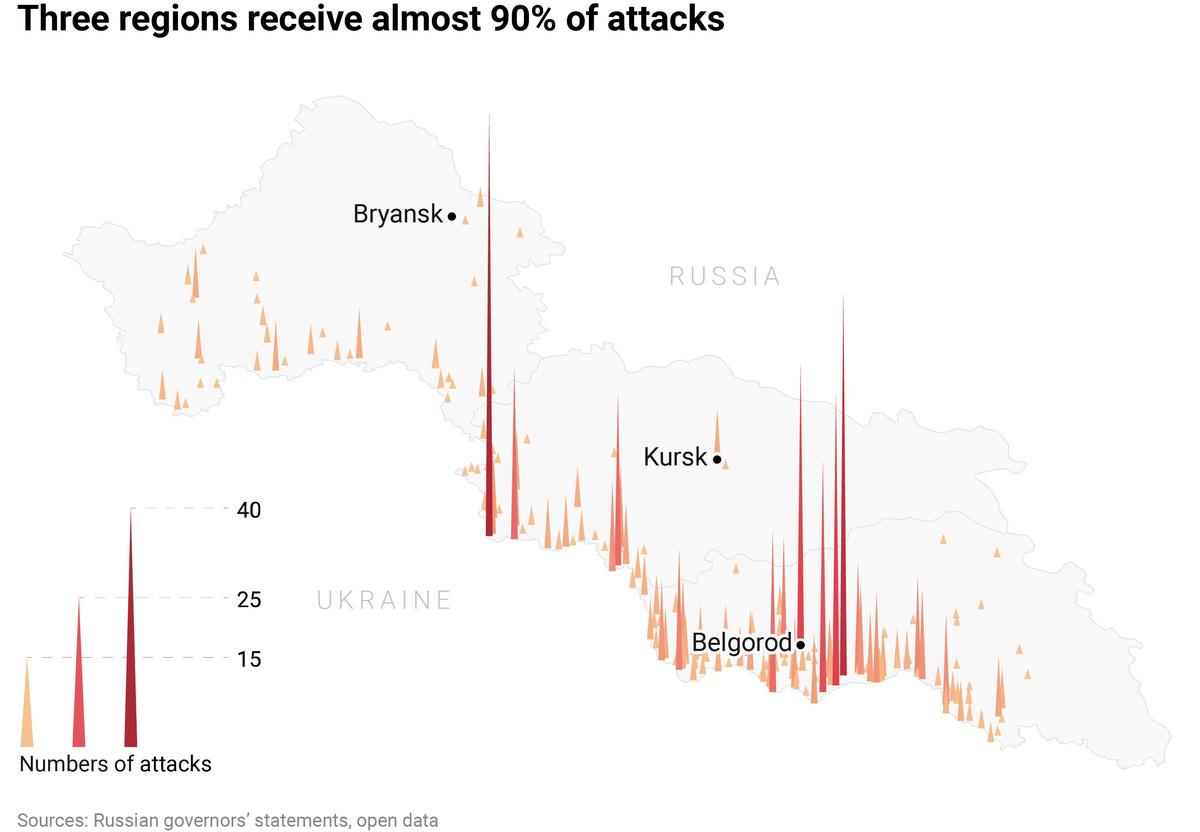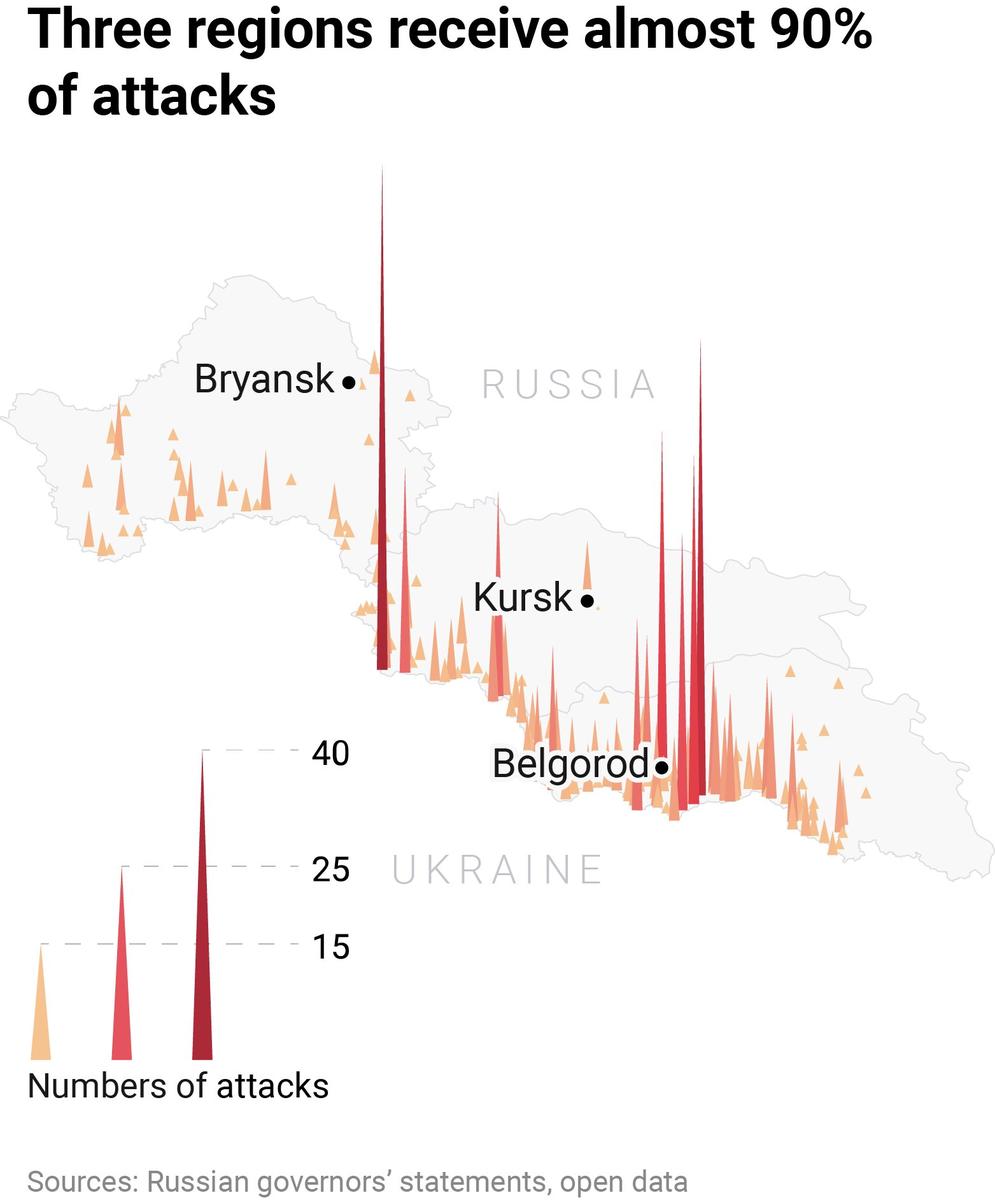“Defending people and, first of all, defending Russia,” is how Vladimir Putin explained the goal of the Ukraine invasion in January 2023. Meanwhile, according to the data posted by Russia’s Federal Security Service (FSB), Russian regions have been attacked over 2,000 times since the start of the war. On 1 June, the town of Shebekino in the Belgorod region, with the population of 40,000 people, was subjected to record-breaking rounds of shelling. In total, 52 civilians have been killed and 242 injured on Russian territory since February 2022 (as of June 2, 2023), Novaya-Europe estimates.
The Kremlin spokesperson Dmitry Peskov said in May that the “special military operation” would continue so as not to let the shelling of Russian territories go on. But with each month of combat, the frequency of air attacks has only grown.
In May, heads of regions reported record-breaking 281 attacks — a number four times higher than in April. On average, about eight towns and villages get shelled daily. Over 2,000 civilian and industrial facilities, including oil terminals, multi-storey residential buildings in Moscow, and the dome of the Kremlin, became the targets of these attacks.
In total, 52 Russian civilians have been killed over the course of the war, and 242 have been wounded. Over half of the victims are from the Belgorod region.
The Russian settlements that get shelled most often are:
- The Tetkino village in the Kursk region. The residents of the village asked to be evacuated a year ago, but only 29 people were moved to temporary accommodation centres. Ukraine’s Armed Forces shelled Tetkino at least eight times in May.
- The town of Shebekino and the neighbouring villages of Murom and Novaya Tavolzhanka. Since the start of the war, this area has been attacked nearly a 100 times.
- The city of Belgorod. On 1 June, drones flew into the city twice. One of the drones crashed into a road, wounding two men. Since the beginning of the war, Belgorod has been subjected to drone attacks 28 times.


Shebekino is a small town 6 km away from the Ukrainian border. Since October, when Ukraine’s Armed Forces began a successful counteroffensive, residents of Shebekino and the near-by villages have been living under constant artillery fire.
On 22 May, the situation in the area grew even more tense — saboteurs invaded the territory of the region, and fighting broke out in the border villages. The Defence Intelligence of the Ministry of Defence of Ukraine confirmed that fighters of the Russian Volunteer Corps and the Freedom of Russia Legion had entered the territory of the Belgorod region. That evening, the local governor declared that a counterterrorism operation was underway in the area, but a day later Russia’s Defence Ministry reported that the sabotage group had been “destroyed”.
After the break in at the border, the shelling of the border villages grew even more frequent.
Every day, at least 15 settlements in the Belgorod region get bombed, and yet general evacuation still hasn’t been declared in the region.
On 31 May, evacuation of children began in Shebekino; the next day, the town suffered the biggest attack since the start of the war — 16 people were hospitalised. Furthermore, on the morning of 1 June, fighters of the Russian Volunteer Corps posted a video in which they claimed to be standing on the Russian border. They added that “very soon, the outskirts of Shebekino will be seen”.
Since the start of the war, at least five sabotage groups have entered the Belgorod region, according to the local governor. “We can expect new raids on the border areas in the coming weeks,” military expert Yury Fyodorov comments. “Ukrainians need to go just a few kilometres deep into Russia to reach their desired goals — to cause public discontent and demonstrate how vulnerable the borders are.”
There have been increasing cases of attacks on targets located thousands of kilometres away from the border. Only in May, drones flew into Moscow twice, but there were also instances of drone attacks in the Voronezh, Kaluga, Pskov, Tver, and Smolensk regions.
On 27 May, drones attacked two oil-processing stations (near the city of Tver and in the Pskov region). On 31 May, there was an attack on two oil refineries in the Krasnodar region. On 2 June, a Transneft station in the Smolensk region was attacked. Drones previously did reach Russian oil terminals, for example, in the town of Tuapse and in Belgorod, but never have they struck industrial targets located so far away from the Ukrainian border.
Since the start of the invasion, drones have targeted Russian oil terminals 16 times, most of the instances happening this spring.
On 30 May, UAVs targeted Moscow and the Moscow region. Russian Telegram channel Baza reported that there were 25 drones, media outlet RBC stated 10 drones had been involved in the attack, while the official figure provided by the Ministry of Defence stands at only eight. Despite the ministry’s statement on the attack being successfully repelled, three drones crashed into multi-storey residential buildings.
According to our estimates, 2,204 civilian, infrastructure, and industrial facilities have been damaged in attacks since the beginning of the war: 25% of them in the last month alone.
In the Belgorod region alone, according to municipal data, 3,644 living quarters were damaged by shelling. Furthermore, 418 of them are not being restored due to the state of emergency declared in the area. At the beginning of February, the local government estimated that housing the residents of destroyed buildings would require 9.4 million rubles (€103,400).
“Oil tanks become drones’ targets because they have military significance, unlike the attacks on the capital. Shelling of Moscow is done to create a psychological effect. It’s a strike on the mass consciousness of Russians,” Yury Fyodorov explains. “Besides, the targets of the drones that crashed into Moscow’s multi-storey buildings were located on the outskirts of the capital, where Russian elites tend to reside.”
“Moscow’s air defence operated as designed, in a satisfactory manner. Although there are things to work on,” Putin declared. Peskov, in his turn, refused to answer questions about the capital’s defence capabilities but noted that the air defence “did well”.
However, according to Novaya-Europe’s calculations, Russian air defence repels only 20% of attacks. “Russian air defence does not function very well, considering it misses attack drones on their way to facilities that should be protected the most,” military expert Yury Fyodorov explains.
The first drone attack on Moscow took place a month ago. The target was the dome of the Kremlin. Before that, drones targeted the Moscow region five times.
The president’s press service called the strike a planned terrorist attack and an attempt on Putin’s life. “Russia reserves the right to take countermeasures wherever and whenever it deems appropriate,” the statement reads.
After the second drone attack on Moscow, Putin once again talked about countermeasures: “They’re provoking us to respond in kind. We’ll see what to do about that.”
The only thing Moscow can respond with are missile strikes against Ukrainian cities, Fyodorov thinks. “Russia will act in the way it’s used to acting — bombings, missile strikes. The Kremlin can’t come up with any other ideas.”
Additional reporting by Lyubov Borisenko and Asya Koshkina
Join us in rebuilding Novaya Gazeta Europe
The Russian government has banned independent media. We were forced to leave our country in order to keep doing our job, telling our readers about what is going on Russia, Ukraine and Europe.
We will continue fighting against warfare and dictatorship. We believe that freedom of speech is the most efficient antidote against tyranny. Support us financially to help us fight for peace and freedom.
By clicking the Support button, you agree to the processing of your personal data.
To cancel a regular donation, please write to [email protected]

